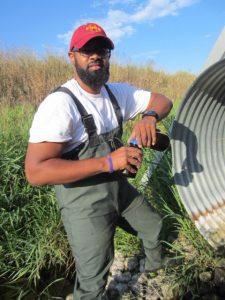A graduate student’s love for the great outdoors inspires him to educate the public about the increasing presence of emerging contaminants – chemical and microbial agents in the environment.

Emerging contaminants might be the next big thing when it comes to future policy-making decisions related to human health and water quality, says Maurice Washington.
Washington, who is pursuing his Ph.D. in agricultural and biosystems engineering at Iowa State University, was first introduced to the issue as an intern at the Metropolitan Water Reclamation District of Greater Chicago, Illinois. While he was there, he learned that wastewater treatment plants are often underequipped to handle certain chemical and microbial agents from sources such as the pharmaceutical industry.
“People often improperly dispose of expired or unused medications by flushing them, which then pushes them through wastewater treatment plants,” he explained. “Those contaminants can harm the microbes that help clean the water. I realized if pharmaceuticals were an issue in urban environments, then they were also a problem in diffuse environments as well.”
After receiving his bachelor’s in agricultural and biological engineering from North Carolina Agricultural and Technical State University in 2009, Washington wanted to continue studying emerging contaminates. So he enrolled at Pennsylvania State University for his master’s degree, where he researched different methods to reduce the concentrations of monensin, a veterinary antibiotic used in dairy production.
He examined composting as one method and found that any type of composting breaks down the antibiotic. Washington discovered that runoff from compost piles was a potential transport mechanism. That work would later form the basis of his current research; investigating transport mechanisms.
He received his master’s in agricultural and biological engineering in 2012, and immediately set out for Iowa to continue his research on emerging contaminants. “I chose Iowa State because it’s the home of agricultural engineering,” he said. “There was also more support and a greater knowledge base for my research.”
Washington is conducting two research projects this summer that study the occurrence, fate and transport of antibiotics and herbicides that are commonly used in Iowa’s agricultural practices.
His first project is a reconnaissance study, monitoring agricultural emerging contaminants (AECs) such as tylosin, sulfamethazine, and the herbicide atrazine in the South Fork Watershed of the Iowa River. The main objectives of this study are to; 1) gain a clearer picture of the extent of AECs exposure 2) the establishment of baseline water quality conditions in the South Fork in response to the use of AECs.
Washington’s research covers five sites that stretch across the southern portion of the South Fork Watershed. Twice a month, he heads into the field to collect grab water samples from active tile drains and sediment samples from the channel beds.
He also uses a passive sampling technology that can detect even the faintest traces of emerging contaminants, called POCIS (Polar Organic Chemical Integrative Sampler). POCIS is comprised of two stainless steel rings and a membrane that essentially uses diffusion to capture and adsorb polar organic contaminants onto the membrane material.
For his second project, Washington is investigating the transport mechanisms of tylosin, sulfamethazine, and atrazine in subsurface soils at Iowa State’s Northeast Research and Demonstration Farm near Nashua, Iowa.
His current research has shown that tile water contains concentrations of agricultural emerging contaminants – leading him to investigate the possibility that they might leach into soils past the tile line.
“We want to see whether all of the emerging contaminants are leaving through the tile, and if some of them are being degraded by microbial activity,” Washington explained. “We’re basically trying to narrow down all of the potential transport mechanisms.”
Data from this study will be used to simulate the fate and transport of the AECs– using the Root Zone Water Quality Model (RZWQM2) – that can predict the potential of pollutant loadings in the subsurface below the rootzone of crops. He says this model might play a role in future policy-making decisions about water quality and human health.
After graduate school, Washington says he wants continue investigating water-quality issues, gain experience in agricultural policy and work abroad. Eventually, he wants to go back into academia as a professor or college researcher where he can recruit more minority students into the STEM disciplines.